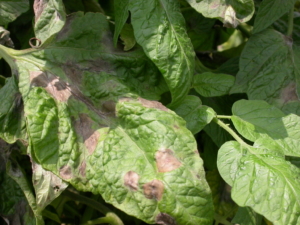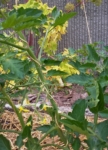Late Blight – Steps to Win the Fight!
May 29, 2022
Knowledge of plant pathogens is very useful in a community garden; your gardening practices can affect
your neighbors’ harvest! Tomatoes and potatoes are the main hosts of late blight, a devastating disease caused by Phytophthora infestans (an oomycete protist that behaves much like a fungus). Even though tomatoes and potatoes are main hosts, many crops in the Solanaceae family can become infected.
Phytophthora thrives in cool, wet conditions and appears near the end of the growing season. In the maritime northwest our plants are especially susceptible if we get early fall showers. Fortunately, late blight can be controlled with good garden hygiene.
for work parties
Please email to volunteer
freewayestatescommunityorchard@gmail
“Cool, wet weather favors late blight development, and hot, dry weather checks it. Infected stems harbor the fungus-like pathogen in dry weather, allowing the disease to spread when damp conditions return.” (Cindy Ocamb, OSU)
Oregon State University recommends the following:
- Buy only healthy-appearing tomato transplants, free of dark lesions on leaves or stems. Plant only healthy-appearing potato seed pieces.
- Destroy volunteer tomatoes and potatoes in your garden, as they may harbor the disease. Remove and bury, or bag and discard, all tomato and potato plant and root pieces.
- When planting, space tomato transplants and potato seed pieces far apart. Stake and prune tomatoes to provide good air circulation.
- Check for the disease regularly, in the early morning, when it shows up best.
- Irrigate your plants in the morning rather than in the afternoon or evening. Avoid wetting the leaves when irrigating – drip irrigation is better than overhead sprinkling.
P. infestans does not overwinter in the soil, but it does survive in plant tissue (UMass). That’s why it is essential that we avoid these common gardener errors that give it a place to hide:
- Failure to provide good circulation – give plants enough space, and stake and prune them properly.
- Failure to promptly and completely remove tomato plants at the end of the season. Rain showers in the fall are bad news for tomatoes. Pull the plants right after harvest and put them into the city yard waste.
- Failure to remove volunteer tomatoes and potatoes. Phytophthora persists in plant tissue. Those cute little plants that pop up from potatoes left in the ground or tomatoes that fell from the vine are ‘Trojan Horses’. They must be removed and put in the city yard waste (not home compost).
We need not cower in the face of Phytophthora infestans. If we are attentive and careful, we can grow healthy tomatoes and potatoes in the cool, damp Maritime Northwest.
Nancy





Thanks, Ruth!